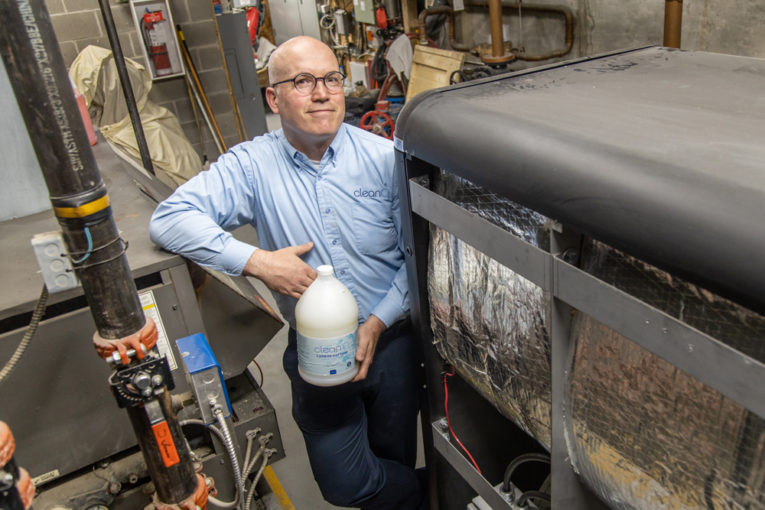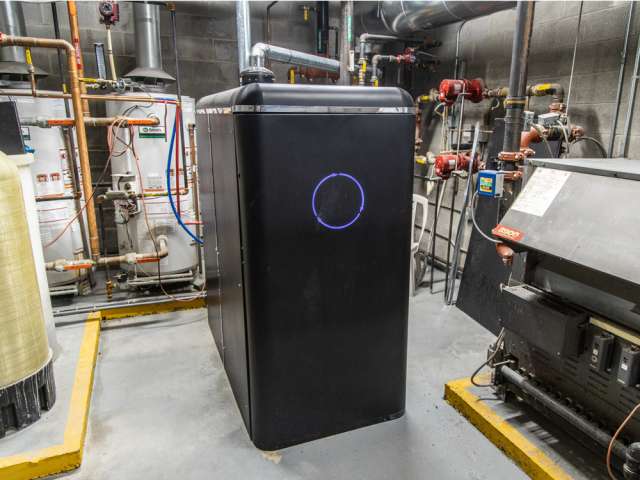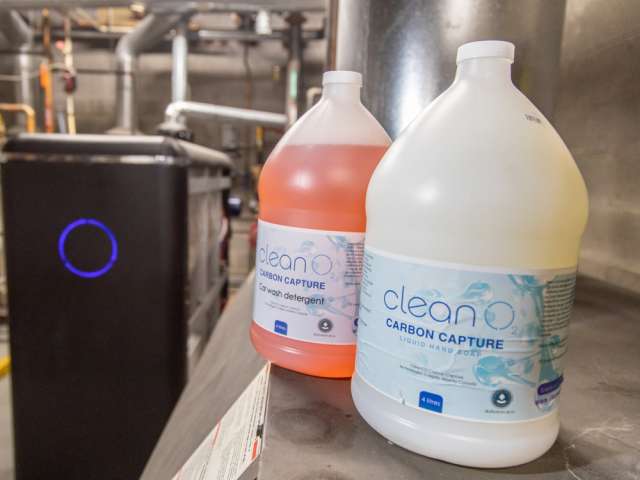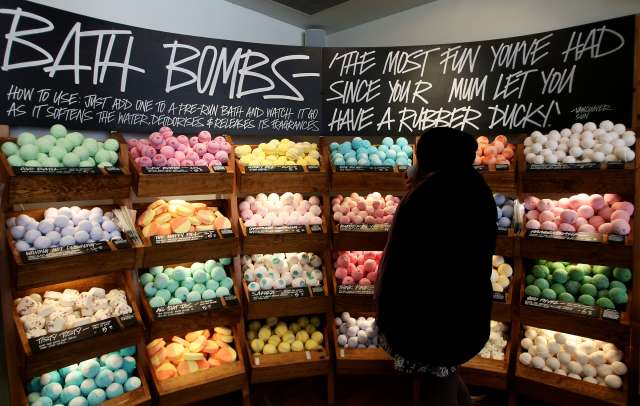
The energy industry gets a bad rap when it comes to innovation, yet the oilpatch is by far the largest spender on clean tech in Canada, to the tune of $1.4 billion a year. As part of its continuing coverage of the innovation economy, the Financial Post reports on the intersection of technology and energy, from the oilpatch in Alberta, off the shores of Nova Scotia to the plains of Saskatchewan.
During an almost disastrous science experiment involving his natural gas-fired furnace, Jaeson Cardiff nearly blew up his house.
“Who doesn’t just happen to have sodium hydroxide in their basement?” joked Cardiff, the CEO and co-founder of CleanO2, who had been tinkering with an early version of a device he built to capture the CO2 that emits from the gas-fired appliance. “I didn’t think. I just threw it in,” he said.
The combination of sodium hydroxide and aluminum, his top chemist later informed him, produces hydrogen gas. And hydrogen gas in the presence of fire — triggered by the ignition on the furnace — can explode.
“Don’t ever do that,” said Kathi Fischer, the chief science officer and co-founder at CleanO2, who helped Cardiff avoid catastrophe and also contributed in finding the right mix of chemicals for the company’s small-scale carbon capture and storage (CCS) device that now, years and multiple iterations later, is called .
By the end of the year, the devices will be installed in 32 different locations in Calgary, Vancouver and Minneapolis after successful pilot projects in the past few years with utility firms ATCO Ltd., FortisBC and UK-based retailer Lush Cosmetics.
, the company’s flagship product, uses chemistry to reduce emissions from furnaces and water heaters while also producing marketable chemical products used in a range of applications from soaps to drilling fluids. Cardiff hopes the device — a jet-black box that looks like an oversized desktop computer — will hit the market with a bang.

Lush Cosmetics, perhaps fittingly, uses the carbon capture device in the production of its fizzy bath bombs that dissolve alka seltzer-like for soothing baths.
CleanO2 is one of several Canadian-based carbon sequestration companies selling into a growing market, which McKinsey and Co. believes could reach US$1.2 trillion by 2030 as countries move to mitigate the impact of climate change.
The Canadian federal government has ambitions of being part of the growth and has set an audacious target of 11.4 per cent growth in clean technology exports for the next six years, which would nearly triple previous growth rates of 4 per cent.
So far, growth has been moderate. CleanO2’s first commercial pilot project was installed in 2015 and since then roughly a dozen units have been installed. But the pace could accelerate as the company’s raises its profile with a string of technology awards and as it gets considerable support from utility companies keen to reduce emissions from the natural gas transmitted to homes and businesses.
Fortis Inc. subsidiary FortisBC, for example, paid the cost of installing multiple units for commercial customers in the Vancouver area that were interested in reducing emissions but were concerned about the high costs of ripping out existing utility infrastructure, said Jason Wolfe, the company’s director of energy solutions.
“This would be perfect for our commercial customers who might be looking to find a new way to reduce emissions without losing the benefit of having natural gas for their business,” Wolfe said, noting that gas-fired heat is significantly cheaper to operate than electric furnaces.
Perfect for our commercial customers who might be looking to find a new way to reduce emissions without losing the benefit of having natural gas for their business
Jason Wolfe, FortisBC
While other CCS companies are focused on the industrial sector, CleanO2 is looking to specifically target owners of commercial and multi-family residential buildings to grow. “Natural gas has to find its place in a carbon constrained world,” said Warren Brooke, the company’s head of engineering. “All of these existing buildings are connected to the natural gas system.”
Carbon capture and storage was once seen by governments as the “panacea” for reducing CO2 emissions and mitigating climate change without massively disrupting existing infrastructure and industries, said University of Calgary School of Public Policy executive fellow Eddy Isaacs, who is also a former CEO of Alberta Innovates.
In 2008, Alberta’s then-premier Ed Stelmach announced a $2 billion fund to advance CCS projects in the province. A portion of the money was used for the Quest CCS project at the Scotford oilsands upgrader, now owned by Canadian Natural Resources Ltd., and for a CCS unit at the North West Refinery, which has yet to process its first barrel of bitumen and is 50 per cent owned by CNRL.

“The expectation was there would be a much greater number of sequestration projects in the world,” Isaacs said of the Alberta government’s initial plan for the CCS fund.
But funding for other CCS projects, including at a gas plant in the Swan Hills area north of Edmonton, were withdrawn and only the Quest and North West Refinery project were subsidized before the fund was wound down. The fund was widely criticized by Alberta’s NDP, which described the large-scale CCS investments as an expensive and inefficient means of combatting climate change. When the NDP rose to power in 2015 in the province, it created a smaller fund to encourage new CCS technologies.
Even as governments scaled back investments in CCS projects, the private sector has been pushing forward with innovative new technologies that are both more affordable and could be more widely deployed, Isaacs said.
A number of small-scale CCS projects have cropped up in Canada in recent years including Dartmouth, Nova Scotia-based CarbonCure Technologies, which injects recycled CO2 into concrete, and Squamish, British Columbia-based Carbon Engineering that has developed a system that sucks CO2 directly out of the air.
“I think there is momentum” in small-scale CCS projects, Isaacs said, though such installations would need to be widely adopted in order to effectively mitigate climate change.
At CleanO2, Cardiff said each device is capable of reducing 6 to 8 tonnes of carbon emissions per year, which may seem small on its own but can be meaningful in aggregate. “This is never going to be a single-point solution. This is an aggregate solution and this is a for-profit solution,” he said.
This is an aggregate solution and this is a for-profit solution
The first commercial device was installed in the boiler room of a southwest Calgary apartment building and has been sucking flue gas out of the vents ever since. The black box is almost identical in size to the building’s furnace and contains a chamber filled with potassium hydroxide. It sucks CO2 into the chamber, mixing it with the potassium hydroxide to cause a chemical reaction that produces heat (used to warm hot water tanks in the boiler room) and potassium carbonate.
Potassium carbonate — a fine, dry white powder — is the main driver of the device’s commercial viability. “The margins, in particular when we sell (the potassium carbonate) to the soap and detergent industry, that’s where we make the majority of our cash,” he said. “If it wasn’t for that, the likelihood of adoption would be very low.”
“If the economics don’t work, it isn’t going to fly. It’s that simple,” Cardiff said.
In this case, the economics do work, he says. The cost of the potassium hydroxide varies but averages about $1,400 per tonne. By contrast, the price of the potassium carbonate that comes out at the end of the process sells for between $1,700 and $4,000 per tonne.
The potassium carbonate is collected every 10 to 15 days and, over the course of the year, adds up to between 4 to 6 tonnes, which can be used to produce a lot of soap bars.
As such, Lush Cosmetics sees the appeal of recycling its carbon emissions directly into its own products. Currently, the company is looking at switching out the potassium in its system to a chemical mix that will produce soda ash, a key ingredient used in its bath bombs.

Dawn-Marie Barreira, sustainable energy management specialist at Lush Cosmetics, says her company uses significantly more carbonate than a CleanO2 unit can produce in a year, so the device hasn’t noticeably offset soap input costs at Lush.
It has, however, helped capture some of the CO2 emitted during the company’s bath bomb manufacturing process — and that was the point. Barreira said the CO2 being vented through the unit was being converted into useful carbonates at a rate in excess of 90 per cent and the company is considering installing another unit at its operations in Toronto.
It’s not lost on Cardiff that his aptly named company is promising to both clean up carbon emissions, while also producing cleaning products. CleanO2 also has commercial agreements with Calgary-based apothecary All Things Jill and Edmonton-based cleaning products company Ostrem Chemical Co. Ltd. to make soap out of the potassium carbonate.
Even the company’s business cards look like little bars of soap, though Cardiff said that wasn’t intentional. Regardless, CleanO2 has become known as the carbon-to-soap company and has received publicity boosts from major companies like CNRL, whose executives have publicly praised the technology, and FortisBC, which hands out CleanO2 dishwasher soap tablets at trade shows.
“That’s a great conversation starter,” FortisBC’s Wolfe said. “This is carbon extract from a furnace in a commercial business, and you can now wash your dishes with it.”
• Email: [email protected] | Twitter: geoffreymorgan
You can read more of the news on source
